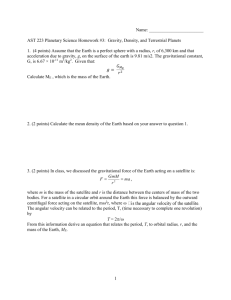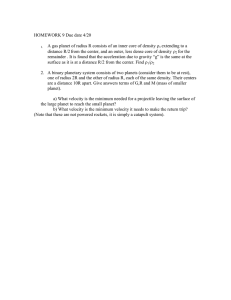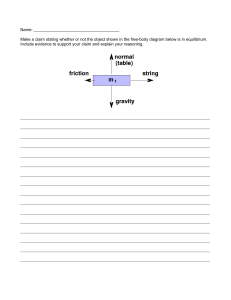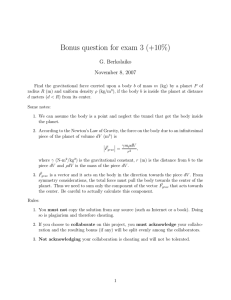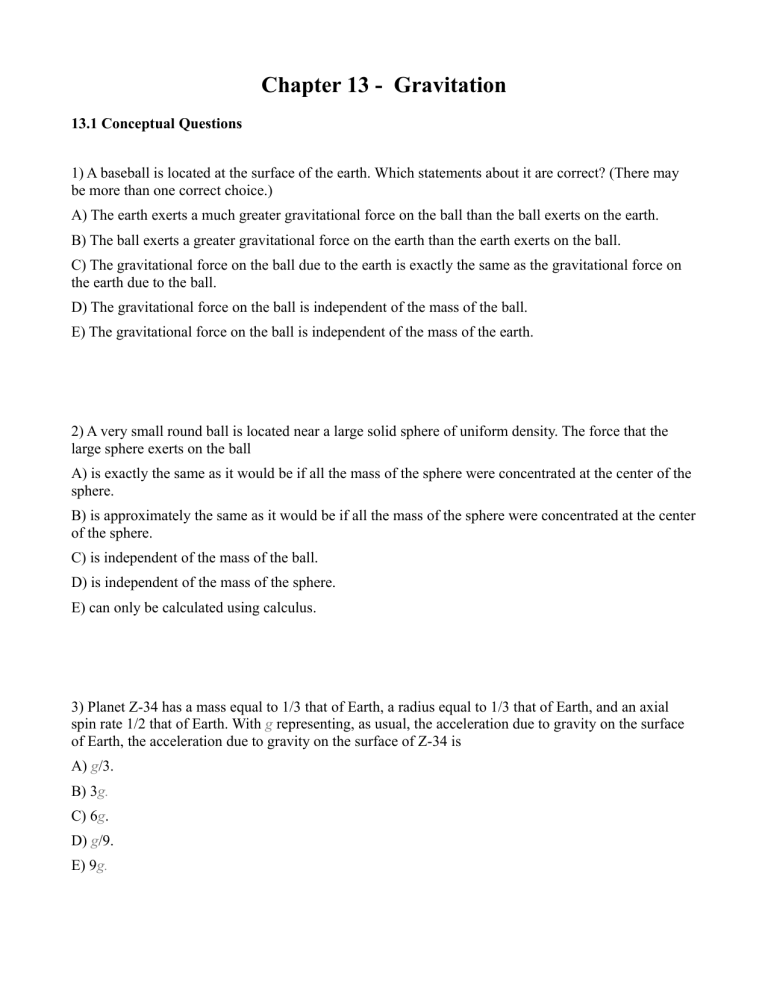
Chapter 13 - Gravitation 13.1 Conceptual Questions 1) A baseball is located at the surface of the earth. Which statements about it are correct? (There may be more than one correct choice.) A) The earth exerts a much greater gravitational force on the ball than the ball exerts on the earth. B) The ball exerts a greater gravitational force on the earth than the earth exerts on the ball. C) The gravitational force on the ball due to the earth is exactly the same as the gravitational force on the earth due to the ball. D) The gravitational force on the ball is independent of the mass of the ball. E) The gravitational force on the ball is independent of the mass of the earth. 2) A very small round ball is located near a large solid sphere of uniform density. The force that the large sphere exerts on the ball A) is exactly the same as it would be if all the mass of the sphere were concentrated at the center of the sphere. B) is approximately the same as it would be if all the mass of the sphere were concentrated at the center of the sphere. C) is independent of the mass of the ball. D) is independent of the mass of the sphere. E) can only be calculated using calculus. 3) Planet Z-34 has a mass equal to 1/3 that of Earth, a radius equal to 1/3 that of Earth, and an axial spin rate 1/2 that of Earth. With g representing, as usual, the acceleration due to gravity on the surface of Earth, the acceleration due to gravity on the surface of Z-34 is A) g/3. B) 3g. C) 6g. D) g/9. E) 9g. 4) If the mass of the earth and all objects on it were suddenly doubled, but the size remained the same, the acceleration due to gravity at the surface would become A) 4 times what it now is. B) 2 times what it now is. C) the same as it now is. D) 1/2 of what it now is. E) 1/4 of what it now is. 5) Two planets having equal masses are in circular orbit around a star. Planet A has a smaller orbital radius than planet B. Which statement is true? A) Planet A has more kinetic energy, less potential energy, and less mechanical energy (potential plus kinetic) than planet B. B) Planet A has more kinetic energy, more potential energy, and more mechanical energy (potential plus kinetic) than planet B. C) Planet A has more kinetic energy, less potential energy, and more mechanical energy (potential plus kinetic) than planet B. D) Planet A and planet B have the same amount of mechanical energy (potential plus kinetic). 6) A certain planet has an escape speed V. If another planet of the same size has twice the mass as the first planet, its escape speed will be A) 2V. B) V. C) V. D) V/2. E) V/. 7) A certain planet has an escape speed V. If another planet has twice size and twice the mass of the first planet, its escape speed will be A) 2V. B) V. C) V. D) V/2. E) V/. 8) A satellite is orbiting the earth. If a payload of material is added until it doubles the satellite’s mass, the earth’s pull of gravity on this satellite will double but the satellite’s orbit will not be affected. A) True B) False 9) A satellite in a circular orbit of radius R around planet X has an orbital period T. If Planet X had onefourth as much mass, the orbital period of this satellite in an orbit of the same radius would be A) 4T. B) 2T. C) T D) T/2. E) T/4. 10) A satellite of mass m has an orbital period T when it is in a circular orbit of radius R around the earth. If the satellite instead had mass 4m, its orbital period would be A) 4T. B) 2T. C) T. D) T/2. E) T/4. 11) The reason an astronaut in an earth satellite feels weightless is that A) the astronaut is beyond the range of the earth’s gravity. B) the astronaut is falling. C) the astronaut is at a point in space where the effects of the moon’s gravity and the earth’s gravity cancel. D) this is a psychological effect associated with rapid motion. E) the astronaut’s acceleration is zero. 12) Because the earth’s orbit is slightly elliptical, the earth actually gets closer to the sun during part of the year. When the earth is closer to the sun its orbital speed is A) less than when the earth is farthest away from the sun. B) the same as when the earth is farthest away from the sun. C) greater than when the earth is farthest away from the sun. 13.2 Problems 1) A small-sized 155-kg mass is located 1.50 m from a small-sized 275-kg mass, with both masses fixed in place. Where should you place a third small-sized mass so that the net gravitational force on it due to the original two masses is zero? 2) An astronaut is in equilibrium when he is positioned 140 km from the center of asteroid X and 581 km from the center of asteroid Y, along the straight line joining the centers of the asteroids. What is the ratio of the masses X/Y of the asteroids? A) 0.0581 B) 17.2 C) 0.241 D) 4.15 3) Three identical very small 50-kg masses are held at the corners of an equilateral triangle, 0.30 m on each side. If one of the masses is released, what is its initial acceleration if the only forces acting on it are the gravitational forces due to the other two masses? (G = 6.67 × 10-11 N ∙ m2/kg2) A) 3.7 × 10-8 m/s2 B) 2.5 × 10-8 m/s2 C) 1.9 × 10-8 m/s2 D) 4.2 × 10-8 m/s2 E) 6.4 × 10-8 m/s2 4) A small planet having a radius of 1000 km exerts a gravitational force of 100 N on an object that is 500 km above its surface. If this object is moved 500 km farther from the planet, the gravitational force on it will be closest to A) 75 N. B) 71 N. C) 56 N. D) 50 N. E) 25 N. 5) The gravitational acceleration on a planet’s surface is 16.0 m/s2. What is the gravitational acceleration at an altitude of one planet diameter above the SURFACE of the planet? A) 5.33 m/s2 B) 1.78 m/s2 C) 1.60 m/s2 D) 4.00 m/s2 E) 8.00 m/s2 6) The radius of the earth is R. At what distance above the earth’s surface will the acceleration of gravity be 4.9 m/s2? A) 0.41R B) 0.50R C) 1.0R D) 1.4R E) 2.0R 7) By how many newtons does the weight of a 100-kg person change when he goes from sea level to an altitude of 5.0 km if we neglect the earth’s rotational effects? (The mean radius of the Earth is 6.38 × 106 m, G = 6.67 × 10-11 N ∙ m2/kg2.) A) -0.60 N B) -1.5 N C) -2.6 N D) -3.6 N E) -5.2 N 8) The weight of spaceman Speff at the surface of planet X, solely due to its gravitational pull, is 389 N. If he moves to a distance of 1.86 × 104 km above the planet’s surface, his weight changes to 24.31 N. What is the mass of planet X, if Speff’s mass is 75.0 kg? (G = 6.67 × 10-11 N ∙ m2/kg2) A) 2.99 × 1024 kg B) 2.99 × 1018 kg C) 2.99 × 1017 kg D) 1.59 × 1018 kg 9) From what height above the surface of the earth should an object be dropped to initially experience an acceleration of 0.9200g? The radius of the earth is 6.38 × 106 m. A) 272 km B) 260 km C) 554 km D) 510 km 10) An object drops a distance h in a time of 6.3 s on the surface of the earth (neglecting air effects). How long would it take the same object to drop the same distance on the surface of spherical asteroid X having a mass of 1.1 × 1022 kg and a radius of 4.0 × 105 m? (G = 6.67 × 10-11 N ∙ m2/kg2, Mearth = 5.97 × 1024 kg, Rearth = 6.38 × 106 m) A) 9.2 s B) 6.3 s C) 5.2 s D) 12 s E) 3.3 s 11) Ekapluto is an unknown planet that has two spherical moons in circular orbits. The table summarizes the hypothetical data about the moons. Both moons have low axial spin rates. (G = 6.67 × 10-11 N ∙ m2/kg2) The acceleration due to gravity at the surface of Moon B is A) 0.10 m/s2. B) 0.15 m/s2. C) 0.20 m/s2. D) 0.25 m/s2. E) 0.30 m/s2. 12) Sputnik I was launched into orbit around Earth in 1957. It had a perigee (the closest approach to Earth, measured from Earth’s center) of 6.81 × 106 m and an apogee (the furthest point from Earth’s center) of 7.53 × 106 m. What was its speed when it was at its perigee? The mass of Earth is 5.97 × 1024 kg and G = 6.67 × 10-11 N ∙ m2/kg2. A) 7180 m/s B) 7840 m/s C) 8230 m/s D) 11,000 m/s E) 13,400 m/s 13) Beings on spherical asteroid Π have observed that a large rock is approaching their asteroid in a collision course. At 7514 km from the center of the asteroid, the rock has a speed of 136.0 m/s and later at 2823 km it has a speed of 392.0 m/s. Use energy conservation to find the mass of asteroid Π. You can neglect any effects due to the parent star of the asteroid. (G = 6.67 × 10-11 N ∙ m2/kg2) A) 4.582 × 1021 kg B) 9.164 × 1027 kg C) 6.112 × 1028 kg D) 4.582 × 1020 kg 14) What is the ratio of the escape speed of a rocket launched from sea level to the escape speed of one launched from Mt. Everest (an altitude of 8.85 km)? The radius of the earth is 6.38 × 106 m. A) 1.0007 B) 1.0014 C) 1.0001 D) 0.9986 E) 0.9993 15) A huge cannon is assembled on an airless planet having insignificant axial spin. The planet has a radius of 5.00 × 106 m and a mass of 3.95 × 1023 kg. The cannon fires a projectile straight up at 2000 m/s. An observation satellite orbits the planet at a height of 1000 km. What is the projectile’s speed as it passes the satellite? (G = 6.67 × 10-11 N ∙ m2/kg2) A) 1500 m/s B) 1380 m/s C) 1610 m/s D) 1280 m/s 16) A meteoroid, heading straight for Earth, has a speed of 14.8 km/s relative to the center of Earth as it crosses our moon’s orbit, a distance of 3.84 × 108 m from the earth’s center. What is the meteoroid’s speed as it hits the earth? You can neglect the effects of the moon, Earth’s atmosphere, and any motion of the earth. (G = 6.67 × 10-11 N ∙ m2/kg2, Mearth = 5.97 × 1024 kg) A) 18.5 km/s B) 21.5 km/s C) 32.4 km/s D) 87.3 km/s 17) A certain spherical asteroid has a mass of 3.5 × 1016 kg and a radius of 8.8 km. What is the minimum speed needed to escape from the surface of this asteroid? (G = 6.67 × 10-11 N ∙ m2/kg2) A) 23 m/s B) 16 m/s C) 520 m/s D) 730 m/s 18) A 910-kg object is released from rest at an altitude of 1200 km above the north pole of the earth. If we ignore atmospheric friction, with what speed does the object strike the surface of the earth? (G = 6.67 × 10-11 N ∙ m2/kg2, Mearth = 5.97 × 1024 kg, the polar radius of the earth is 6357 km) A) 4.5 km/s B) 2.2 km/s C) 2.7 km/s D) 3.2 km/s E) 4.8 km/s 19) A satellite is in circular orbit at an altitude of 1500 km above the surface of a nonrotating planet with an orbital speed of 9.2 km/s. The minimum speed needed to escape from the surface of the planet is 14.9 km/s, and G = 6.67 × 10-11 N ∙ m2/kg2. The orbital period of the satellite is closest to A) 72 min. B) 65 min. C) 58 min. D) 51 min. E) 44 min. 20) A satellite is in circular orbit at an altitude of 2300 km above the surface of a nonrotating asteroid with an orbital speed of 5.9 km/s. The minimum speed needed to escape from the surface of the asteroid is 14.6 km/s, and G = 6.67 × 10-11 N ∙ m2/kg2. The mass of the asteroid is closest to A) 1.8 × 1024 kg. B) 8.9 × 1023 kg. C) 1.3 × 1024 kg. D) 2.7 × 1024 kg. E) 3.6 × 1024 kg. 21) An astronaut is standing on the surface of a planetary satellite that has a radius of 1.74 × 106 m and a mass of 7.35 × 1022 kg. An experiment is planned where a projectile needs to be launched straight up from the surface. What must be the minimum initial speed of the projectile so it will reach a height of 2.55 × 106 m above this satellite’s surface? (G = 6.67 × 10-11 N ∙ m2/kg2) 22) The International Space Station is orbiting at an altitude of about 370 km above the earth’s surface. The mass of the earth is 5.97 × 1024 kg, the radius of the earth is 6.38 × 106 m, and G = 6.67 × 10-11 N ∙ m2/kg2. Assuming a circular orbit, (a) what is the period of the International Space Station’s orbit? (b) what is the speed of the International Space Station in its orbit? 23) A satellite that weighs 4900 N on the launchpad travels around the earth’s equator in a circular orbit with a period of 1.667 h. The earth’s mass is 5.97 × 1024 kg, its equatorial radius is 6.3 × 106 m, and G = 6.67 × 10-11 N ∙ m2/kg2. (a) Calculate the magnitude of the earth’s gravitational force on the satellite. (b) Determine the altitude of the satellite above the Earth’s SURFACE. 24) What is the period (in hours) of a satellite circling Mars 100 km above the planet’s surface? The mass of Mars is 6.42 × 1023 kg, its radius is 3.40 × 106 m, and G = 6.67 × 10-11 N ∙ m2/kg2. A) 1.75 h B) 1.25 h C) 1.15 h D) 1.00 h E) 1.45 h 25) Jupiter completes one revolution about its own axis every 9.92 hours. What is the radius of the orbit required for a satellite to revolve about Jupiter with the same period? Jupiter has a mass of 1.90 × 1027 kg and G = 6.67 × 10-11 N ∙ m2/kg2. A) 1.04 × 107 m B) 2.26 × 109 m C) 1.60 × 108 m D) 3.41 × 108 m E) 7.45 × 108 m 26) The moons of Mars, Phobos (Fear) and Deimos (Terror), are very close to the planet compared to Earth’s Moon. Their orbital radii are 9,378 km and 23,459 km respectively. What is the ratio of the orbital speed of Phobos to that of Deimos? A) 0.2528 B) 0.3998 C) 1.582 D) 2.858 E) 3.956 27) Spaceman Speff orbits spherical asteroid X with his spaceship. To remain in a circular orbit at 421 km from the asteroid’s center, he should maintain a speed of 80 m/s. What is the mass of planet X? (G = 6.67 × 10-11 N ∙ m2/kg2) A) 4.0 × 1019 kg B) 5.1 × 1017 kg C) 4.0 × 1016 kg D) 5.1 × 1014 kg 28) Find the orbital speed of an ice cube in the rings of Saturn. The mass of Saturn is 5.68 × 1026 kg and the rings have an average radius of 100,000 km. (G = 6.67 × 10-11 N ∙ m2/kg2) A) 19.5 km/s B) 27.5 km/s C) 13.8 km/s D) 1.95 km/s 29) You are the science officer on a visit to a distant solar system. Prior to landing on a planet you measure its diameter to be 1.8 × 107 m and its rotation period to be 22.3 hours. You have previously determined that the planet orbits 1.8 × 1011 m from its star with a period of 402 earth days. Once on the surface you find that the acceleration due to gravity is 59.7 m/s2. What are the mass of (a) the planet and (b) the star? (G = 6.67 × 10-11 N ∙ m2/kg2.) A) (a) 7.2 kg × 1025 kg, (b) 2.9 kg × 1030 kg B) (a) 1.3 kg × 1026 kg, (b) 2.9 kg × 1030 kg C) (a) 7.2 kg × 1025 kg, (b) 1.7 kg × 1030 kg D) (a) 1.3 kg × 1026 kg, (b) 1.7 kg × 1030 kg 30) Suppose we want a satellite to revolve around the earth 5 times a day. What should be the radius of its orbit? (The mass of the earth is 5.97 × 1024 kg, G = 6.67 × 10-11 N ∙ m2/kg2, and you can neglect the presence of the moon.) A) 1.44 × 107 m B) 0.690 × 107 m C) 7.22 × 107 m D) 2.11 × 107 m 31) Ekapluto is an unknown planet that has two moons in circular orbits. The table summarizes the hypothetical data about the moons. (G = 6.67 × 10-11 N ∙ m2/kg2) Mass Radius Orbital radius Orbital period Moon A 4.0 × 1020 kg Moon B 1.5 × 1020 kg 2.0 × 108 m 2.0 × 105 m 4.0 × 106 s 3.0 × 108 m The mass of Ekapluto is closest to A) 1.0 × 1022 kg. B) 3.0 × 1022 kg. C) 1.0 × 1023 kg. D) 3.0 × 1023 kg. E) 1.0 × 1024 kg. 32) A man-made satellite of mass 6105 kg is in orbit around the earth, making one revolution in 430 minutes. What is the magnitude of the gravitational force exerted on the satellite by the earth? (The mass of the earth is 6.0 × 1024 kg and G = 6.67 × 10-11 N ∙ m2/kg2) 33) A planet has two small satellites in circular orbits around the planet. The first satellite has a period 18.0 hours and an orbital radius 2.00 × 107 m. The second planet has an orbital radius 3.00 × 107 m. What is the period of the second satellite? A) 60.8 h B) 12.0 h C) 33.1 h D) 9.80 h E) 27.0 h 34) A planet has two small satellites in circular orbits around the planet. The first satellite has a period 12.0 hours and an orbital radius 6.00 × 107 m. The second planet has a period 16.0 hours. What is the orbital radius of the second satellite? A) 4.50 × 107 B) 3.90 × 107 C) 9.24 × 107 D) 8.00 × 107 E) 7.27 × 107 35) Neptune circles the Sun at a distance of 4.50 × 1012 m once every 164 years. Saturn circles the Sun at a distance of 1.43 x 1012 m. What is the orbital period of Saturn? A) 304 y B) 121 y C) 109 h D) 88.6 y E) 29.4 y 36) The moons of Mars, Phobos (Fear) and Deimos (Terror), are very close to the planet compared to Earth’s Moon. Their orbital radii are 9,378 km and 23,459 km respectively. What is the ratio of the period of revolution of Phobos to that of Deimos? A) 0.2528 B) 0.3998 C) 1.582 D) 2.858 E) 3.956 37) Two moons orbit a planet in nearly circular orbits. Moon A has orbital radius r, and moon B has orbital radius 4r. Moon A takes 20 days to complete one orbit. How long does it take moon B to complete an orbit? A) 20 d B) 40 d C) 80 d D) 160 d E) 320 d 38) Ekapluto is an unknown planet that has two moons in circular orbits. The table summarizes the hypothetical data about the moons. Mass Moon A 4.0 × 1020 kg Moon B 1.5 × 1020 kg Radius 2.0 × 105 m Orbital radius Orbital period 2.0 × 108 m 4.0 × 106 s 3.0 × 108 m The orbital period of Moon B is closest to A) 5.6 × 106 s. B) 6.0 × 106 s. C) 6.4 × 106 s. D) 6.9 × 106 s. E) 7.3 × 106 s.

